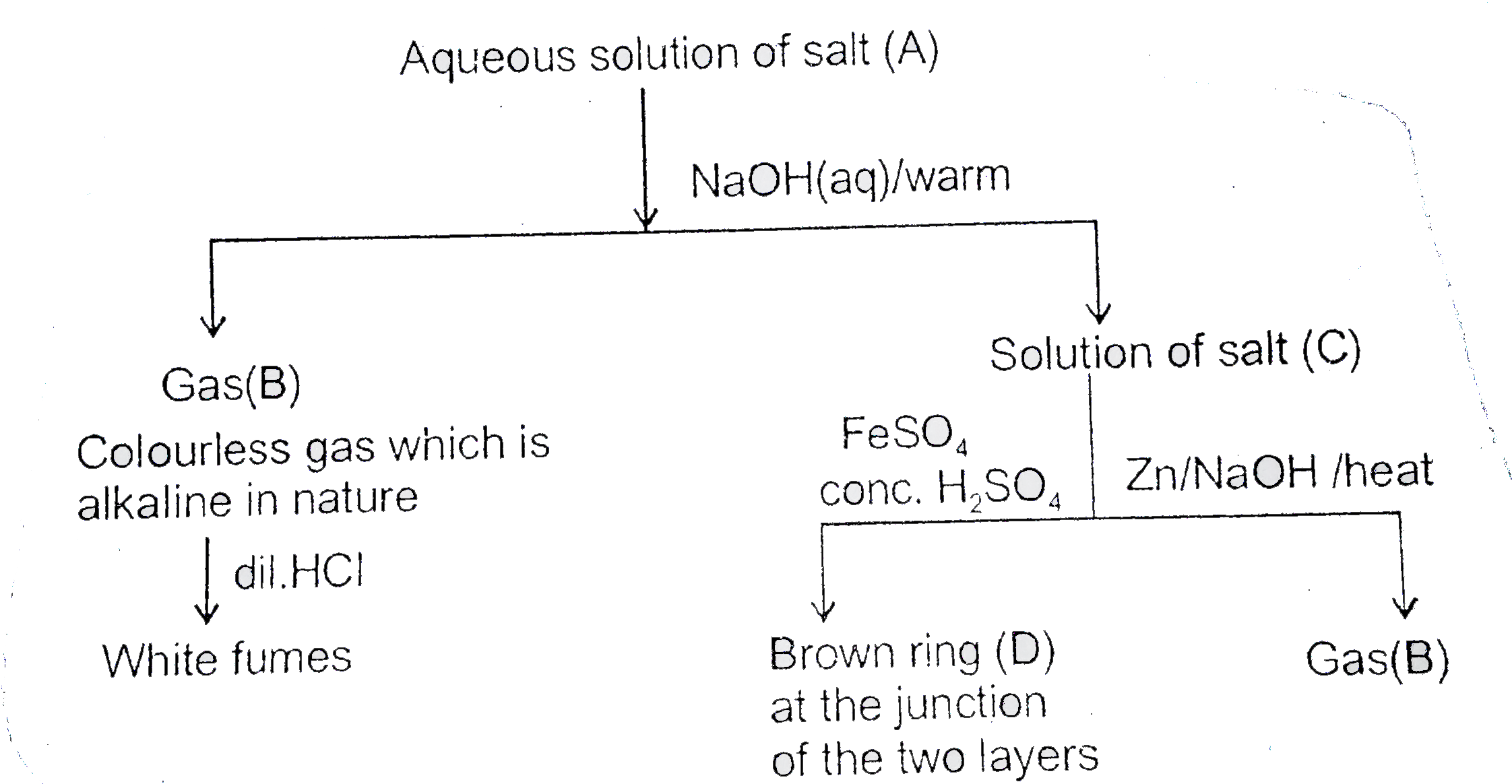A chloride salt on addition of alkali solution gives gas B whicch gives brownn ppt. with nessler's regent. What is A, B and C?
NH4Cl,NH3andHgO⋅Hg(NH2)(NO3)
NH4Cl,NH3andHg(NH3)Cl
NH4Cl,NH3andHgO⋅Hg(NH2)Cl
NH4Cl,NH3andHgO⋅Hg(NH2)I
The correct Answer is:D
To solve the problem, we need to identify the chloride salt (A), the gas produced (B), and the brown precipitate formed with Nessler's reagent (C).
1. Identify the Chloride Salt (A):
- The problem states that a chloride salt reacts with an alkali solution. A common chloride salt that fits this description is Ammonium Chloride (NH4Cl).
2. Reaction with Alkali:
- When Ammonium Chloride (NH4Cl) is treated with an alkali, such as Sodium Hydroxide (NaOH), the following reaction occurs:
NH4Cl+NaOH→NaCl+NH3+H2O
- In this reaction, Ammonium Chloride reacts with Sodium Hydroxide to produce Sodium Chloride (NaCl), Ammonia (NH3), and water (H2O).
3. Identify the Gas (B):
- The gas produced in this reaction is Ammonia (NH3). This is the gas (B) mentioned in the question.
4. Nessler's Reagent Reaction:
- Nessler's reagent, which is a solution of potassium tetraiodomercurate(II) (K2HgI4) in the presence of KOH, reacts with Ammonia (NH3) to form a brown precipitate. The reaction can be represented as:
NH3+K2HgI4→Hg2I2⋅NH2+KOH
- The brown precipitate formed is Mercuric Ammonium Iodide (Hg2I2·NH2), which is the brown precipitate (C) referred to in the question.
5. Final Identification:
- Thus, we can summarize:
- A (Chloride Salt) = Ammonium Chloride (NH4Cl)
- B (Gas) = Ammonia (NH3)
- C (Brown Precipitate) = Mercuric Ammonium Iodide (Hg2I2·NH2)
Conclusion:
- The answer to the question is:
- A = Ammonium Chloride (NH4Cl)
- B = Ammonia (NH3)
- C = Mercuric Ammonium Iodide (Hg2I2·NH2)
- The problem states that a chloride salt reacts with an alkali solution. A common chloride salt that fits this description is Ammonium Chloride (NH4Cl).
- When Ammonium Chloride (NH4Cl) is treated with an alkali, such as Sodium Hydroxide (NaOH), the following reaction occurs:
NH4Cl+NaOH→NaCl+NH3+H2O
- In this reaction, Ammonium Chloride reacts with Sodium Hydroxide to produce Sodium Chloride (NaCl), Ammonia (NH3), and water (H2O).
- The gas produced in this reaction is Ammonia (NH3). This is the gas (B) mentioned in the question.
- Nessler's reagent, which is a solution of potassium tetraiodomercurate(II) (K2HgI4) in the presence of KOH, reacts with Ammonia (NH3) to form a brown precipitate. The reaction can be represented as:
NH3+K2HgI4→Hg2I2⋅NH2+KOH
- The brown precipitate formed is Mercuric Ammonium Iodide (Hg2I2·NH2), which is the brown precipitate (C) referred to in the question.
- Thus, we can summarize:
- A (Chloride Salt) = Ammonium Chloride (NH4Cl)
- B (Gas) = Ammonia (NH3)
- C (Brown Precipitate) = Mercuric Ammonium Iodide (Hg2I2·NH2)
- The answer to the question is:
- A = Ammonium Chloride (NH4Cl)
- B = Ammonia (NH3)
- C = Mercuric Ammonium Iodide (Hg2I2·NH2)
Topper's Solved these Questions
- QUALITATIVE INORGANIC ANALYSISBOOK - VK JAISWAL ENGLISHCHAPTER - QUALITATIVE INORGANIC ANALYSISEXERCISE - LEVEL 2
76 Videos
- QUALITATIVE INORGANIC ANALYSISBOOK - VK JAISWAL ENGLISHCHAPTER - QUALITATIVE INORGANIC ANALYSISEXERCISE - LEVEL 3
62 Videos
- PERIODIC PROPERTIESBOOK - VK JAISWAL ENGLISHCHAPTER - PERIODIC PROPERTIESEXERCISE - MATCH THE COLUMN
11 Videos
- s-BLOCK ELEMENTSBOOK - VK JAISWAL ENGLISHCHAPTER - s-BLOCK ELEMENTSEXERCISE - SUBJECTIVE PROBLEMS
2 Videos
Similar Questions

Salt(A) on heating gives a colourless neutral gas which supports combustion.
From the aforesaid, flow diagram, answer the following questions.
The basic radical of salt (A) and gas B both gives brown precipitate with Nessler's reagent.The composition of the brown precipitate is:
View SolutionA white sublimable solid, when boiled with an NaOH solution, gives a colourless gas that turns nessler's reagent brown. The solid on being heated with solid K2Cr2O7 and concentrated H2SO4, gives red brown vapours. The white solid can be:
View SolutionA solution of a salt in water, on addition of dilute HCI, gives a white precipitate, which is soluble in hot water. The salt contains
View SolutionA white crystalline solid 'A' on boiling with caustic soda solution gives a gas 'B', which on passing through an alkaline solution of ptassium tetraiodomercurate (II) solution gives a brown ppt. the substance 'A' on heating eveolves a neutral gas 'C', which is inert at room temperature and reactive a presence of catalyst and does ont give grown fumes with nitric oxide.
Q. The gas 'B' is:
View SolutionA white crystalline solid 'A' on boiling with caustic soda solution gives a gas 'B', which on passing through an alkaline solution of ptassium tetraiodomercurate (II) solution gives a brown ppt. the substance 'A' on heating eveolves a neutral gas 'C', which is inert at room temperature and reactive a presence of catalyst and does ont give grown fumes with nitric oxide.
Q. The gas 'C' is:
View SolutionSalt (A) gives brick red fumes (B) with conc. H2SO4andK2Cr2O7 which gives yellow solution (C) with NaOH and it gives yellow ppt. (D) with acetic acid and lead acetate. What is (C)?
View SolutionExplain the following facts:
(a). Copper hydroxide is soluble in ammonium hydroxide but not in sodium hydeoxide.
(b). Addition of an alkali to cuprous chloride solution gives a yellow precipitate which gradually changes to a red colour.
View SolutionSolution A is a strong acid
Solution B is a weak alkali
Solution C is a strong alkali
Which solution will give a gelatinous white precipitate with zinc sulphate solution ? The precipitate disappears when an excess of the solution is added.
View SolutionThe salt which in solution gives a pale green ppt. with NaOH soln. & a white ppt. with barium chloride soln is:
View SolutionSolution A is a strong acid
Solution B is a weak alkali
Solution C is a strong alkali
Which solution contains solute molecules in addition to water molecules ?
View Solution
